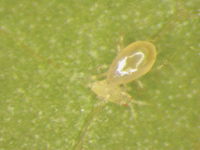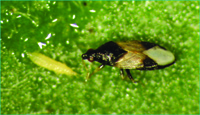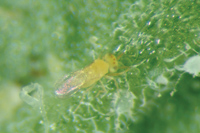
Features
Crop Protection
Inputs
Integrating your IPM
June 21, 2010 By Angela Gradish Cynthia Scott-Dupree Les Shipp Ron Harris and Gillian Ferguson
Greenhouse vegetables are sold exclusively for fresh consumption and the
demand for blemish-free produce from consumers makes effective pest
management crucial.
 |
|
| Two commercially available biological control agents: Adult Orius insidiosus. |
|
 |
|
| Figure 2. Adult Amblyseius swirskii. | |
 |
|
| Figure 3. Adult Eretmocerus eremicus. |
|
 |
|
| Figure 4. Average corrected per cent mortality of Orius insidiosus adults 48 hours after exposure to leaf residues of insecticides (abamectin, metaflumizone, and chlorantraniliprole) or fungicides (myclobutanil, potassium bicarbonate, and cyprodinil + fludioxonil) in laboratory trials. Columns with the same letter are not significantly different (Tukey’s; a = 0.05). |
|
 |
|
| Figure 5. Average corrected per cent mortality of Amblyseius swirskii adults 48 hours after exposure to leaf residues of insecticides (abamectin, metaflumizone, and chlorantraniliprole) or fungicides (myclobutanil, potassium bicarbonate, and cyprodinil + fludioxonil) in laboratory trials. Columns with the same letter are not significantly different (Tukey’s; a = 0.05). |
|
 |
|
| Figure 6. Average corrected per cent mortality of Eretmocerus eremicus adults 48 hours after exposure to leaf residues of insecticides (abamectin, metaflumizone, and chlorantraniliprole) or fungicides (myclobutanil, potassium bicarbonate, and cyprodinil + fludioxonil) at label rate for greenhouse use in laboratory trials. Columns with the same letter are not significantly different (Tukey’s; a = 0.05). |
|
 |
|
| Figure 7. Average corrected per cent mortality of Orius insidiosus, Amblyseius swirskii, and Eretmocerus eremicus adults 24 hours following exposure to 24 hours residues of insecticides and fungicides on greenhouse cucumber. Data for A. swirskii did not meet the assumptions for statistical analysis. For O. insidiosus and E. eremicus, columns with the same letter within the same species grouping are not significantly different (Tukey’s, a = 0.05). |
Greenhouse vegetables are sold exclusively for fresh consumption and the demand for blemish-free produce from consumers makes effective pest management crucial. Integrated pest management (IPM), which combines a variety of control tactics designed to reduce pest populations below economic thresholds, is commonly practised for control of insect and disease pests. In particular, greenhouse vegetable growers rely heavily on biological control as part of IPM programs for insect pests.
Biological control, which is the use of a natural predator, parasite, or pathogen to reduce pest populations, has many advantages: it is easy to apply, it is effective, and it reduces pesticide application, which minimizes product residues, worker exposure and environmental pollution. Currently, western flower thrips (WFT) and greenhouse whitefly (GWF) are primarily managed using commercially available arthropod biological control agents (BCA).
PESTICIDES REMAIN IMPORTANT TOOL IN GREENHOUSE IPM PROGRAMS
Despite the success of biological control, pesticides remain an important tactic in greenhouse IPM programs as not all pests have an associated BCA. For instance, many insect pests still require supplemental insecticide application and fungicides remain the primary control method for powdery mildew. Many of these pests have developed resistance to currently registered products and therefore there is a need for the development of new pesticides with alternative modes of action.
However, pesticides can have negative, non-target effects, specifically on BCAs. Biological control agents are at risk of pesticide exposure in greenhouses by direct contact with spray during foliar application or by contacting residues on plants, both of which can result in mortality. Because BCAs are purchased from commercial companies, their mortality can result in substantial economic loss. The loss of BCA populations also can cause pest resurgence or a secondary pest outbreak resulting from loss of control of the BCA’s target pest.
Pesticide toxicity to arthropod BCAs varies and is dependent on pesticide type, BCA species, and route of exposure. Generally, insecticides can be particularly harmful to BCAs. Much less is known about the impact of fungicides, but in some cases they are known to be harmful. Therefore, knowledge of pesticide toxicity to BCAs is necessary for successful integration of biological and chemical control methods in greenhouse IPM.
STUDY LOOKED AT POTENTIAL IMPACT OF PESTICIDES ON BCAs
To assess the potential impact of pesticides on BCAs, a study was recently conducted at the University of Guelph by Angela Gradish under the supervision of Drs. Cynthia Scott-Dupree (University of Guelph) and Les Shipp (Agriculture and Agri-Food Canada) and in collaboration with Dr. Ron Harris (University of Guelph) and Gillian Ferguson (Ontario Ministry of Agriculture, Food and Rural Affairs). The study examined the toxicity of some insecticides and fungicides currently used or in the process of being registered for use in Canadian greenhouse vegetable production to some adult BCAs. The objective of the study was to identify pesticides that are safe to apply in greenhouses in the presence of various BCAs [Orius insidiosus (Figure 1),
Amblyseius swirskii (Figure 2), and Eretmocerus eremicus (Figure 3)] used for WFT or GWF control.
The insecticides tested included imidacloprid (Intercept®, Bayer CropScience Canada), abamectin (Avid®, Syngenta Crop Protection Canada Inc.), metaflumizone (Alverde™ BASF Canada), and chlorantraniliprole (Coragen®, Dupont Canada). Alverde is being registered for lygus bug in pepper and cucumber beetle in cucumber, while Coragen is registered for cabbage looper. The fungicides tested included myclobutanil (Nova®, Dow Agrosciences Canada), potassium bicarbonate (Milstop®, Bioworks Inc.), and cyprodinil + fludioxonil (Switch®, Syngenta Crop Protection Canada Inc.). Pesticide toxicity was ranked based on a system created by the International Organization for Biological Control: harmless (caused <25 per cent mortality), slightly harmful (25-50 per cent), moderately harmful (51-75 per cent), or harmful (>75 per cent).
LABORATORY AND GREENHOUSE EXPERIMENTS WERE CONDUCTED
Both laboratory and greenhouse experiments were performed. For laboratory trials, green bean leaves were dipped in each pesticide mixed at label rate for greenhouse use. Adults of each species of BCA were then exposed to the dried, treated leaves for 48 hours, at which time mortality was assessed.
The pesticides tested in greenhouse trials included abamectin, metaflumizone, potassium bicarbonate, and cyprodinil + fludioxonil. Abamectin and metaflumizone were slightly harmful to one or more BCA in laboratory trials and therefore further evaluation of these products was necessary. Potassium bicarbonate and cyprodinil + fludioxonil were both new products with little associated toxicity information. Greenhouse experiments were performed at the Greenhouse and Processing Crops Research Centre, Agriculture and Agri-Food Canada, in Harrow, Ontario. Cucumber was grown using commercial practices until eighth to ninth leaf stage. Each pesticide was then applied at label rate to the plants using a backpack sprayer. Adults of each BCA were caged on the plants one and eight days after treatment. If a pesticide was slightly harmful to harmful at day eight, further testing occurred at day 15. Mortality was determined at 24 hours at each residual time.
THE RESULTS
In laboratory trials, abamectin was slightly harmful to Orius insidiosus at label rate, but all other treatments were harmless (Figure 4). Similarly, all pesticides tested were harmless to Amblyseius swirskii (Figure 5). Metaflumizone was slightly harmful to Eretmocerus eremicus at label rate; however, all other treatments were harmless (Figure 6).
In greenhouse trials, all pesticides were harmless to O. insidiosus and A. swirskii one and eight days after treatment (Figure 7). Similarly, all pesticides, with the exception of metaflumizone, were harmless to E. eremicus. Metaflumizone was slightly harmful one and eight days after treatment; however, it was harmless 15 days after treatment (Figure 7).
These results indicate that, in general, the new insecticides chlorantraniliprole and metaflumizone are safe to apply in greenhouses where O. insidiosus, A. swirskii, and E. eremicus are released for WFT and/or GWF management. Metaflumizone was slightly harmful to E. eremicus and should be applied with caution where these parasitoids are released. However, reintroduction of E. eremicus two weeks after application should be safe. Finally, all fungicides tested can be safely applied for powdery mildew management in the presence of all three species of BCA. With their novel modes of action and low toxicity to BCAs, these pesticides are promising additions to greenhouse vegetable IPM programs in Canada. ■
Funding for this research was provided by the Pest Management Centre of AAFC and a CORD IV grant provided to the Ontario Greenhouse Vegetable Growers by the Agricultural Adaption Council.
Print this page